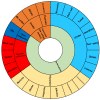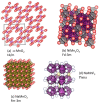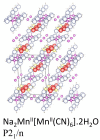Review and New Perspectives on Non-Layered Manganese Compounds as Electrode Material for Sodium-Ion Batteries
- PMID: 37959567
- PMCID: PMC10649210
- DOI: 10.3390/ma16216970
Review and New Perspectives on Non-Layered Manganese Compounds as Electrode Material for Sodium-Ion Batteries
Abstract
After more than 30 years of delay compared to lithium-ion batteries, sodium analogs are now emerging in the market. This is a result of the concerns regarding sustainability and production costs of the former, as well as issues related to safety and toxicity. Electrode materials for the new sodium-ion batteries may contain available and sustainable elements such as sodium itself, as well as iron or manganese, while eliminating the common cobalt cathode compounds and copper anode current collectors for lithium-ion batteries. The multiple oxidation states, abundance, and availability of manganese favor its use, as it was shown early on for primary batteries. Regarding structural considerations, an extraordinarily successful group of cathode materials are layered oxides of sodium, and transition metals, with manganese being the major component. However, other technologies point towards Prussian blue analogs, NASICON-related phosphates, and fluorophosphates. The role of manganese in these structural families and other oxide or halide compounds has until now not been fully explored. In this direction, the present review paper deals with the different Mn-containing solids with a non-layered structure already evaluated. The study aims to systematize the current knowledge on this topic and highlight new possibilities for further study, such as the concept of entatic state applied to electrodes.
Keywords: manganese compounds; multianion; phosphate; post-lithium batteries; sodium-ion batteries; spinel.
Conflict of interest statement
The authors declare no conflict of interest. The funders had no role in the design of the study; in the collection, analyses, or interpretation of data; in the writing of the manuscript, or in the decision to publish the results.
Figures
















References
-
- Hu Z., Gao S. Upper crustal abundances of trace elements: A revision and update. Chem. Geol. 2008;253:205–221. doi: 10.1016/j.chemgeo.2008.05.010. - DOI
-
- Yaroshevsky A.A. Abundances of chemical elements in the Earth’s crust. Geochem. Int. 2006;44:48–55. doi: 10.1134/S001670290601006X. - DOI
-
- Parant J.P., Olazcuaga R., Devalette M., Fouassier C., Hagenmuller P. Sur quelques nouvelles phases de formule NaxMnO2 (x ≤ 1) J. Solid State Chem. 1971;3:1–11. doi: 10.1016/0022-4596(71)90001-6. - DOI
-
- Mendiboure A., Delmas C., Hagenmuller P. Electrochemical intercalation and deintercalation of NaxMnO2 bronzes. J. Solid State Chem. 1985;57:323–331. doi: 10.1016/0022-4596(85)90194-X. - DOI
-
- Hunter J.C. Preparation of a new crystal form of manganese dioxide: λ-MnO2. J. Solid State Chem. 1981;39:142–147. doi: 10.1016/0022-4596(81)90323-6. - DOI
Publication types
Grants and funding
LinkOut - more resources
Full Text Sources

